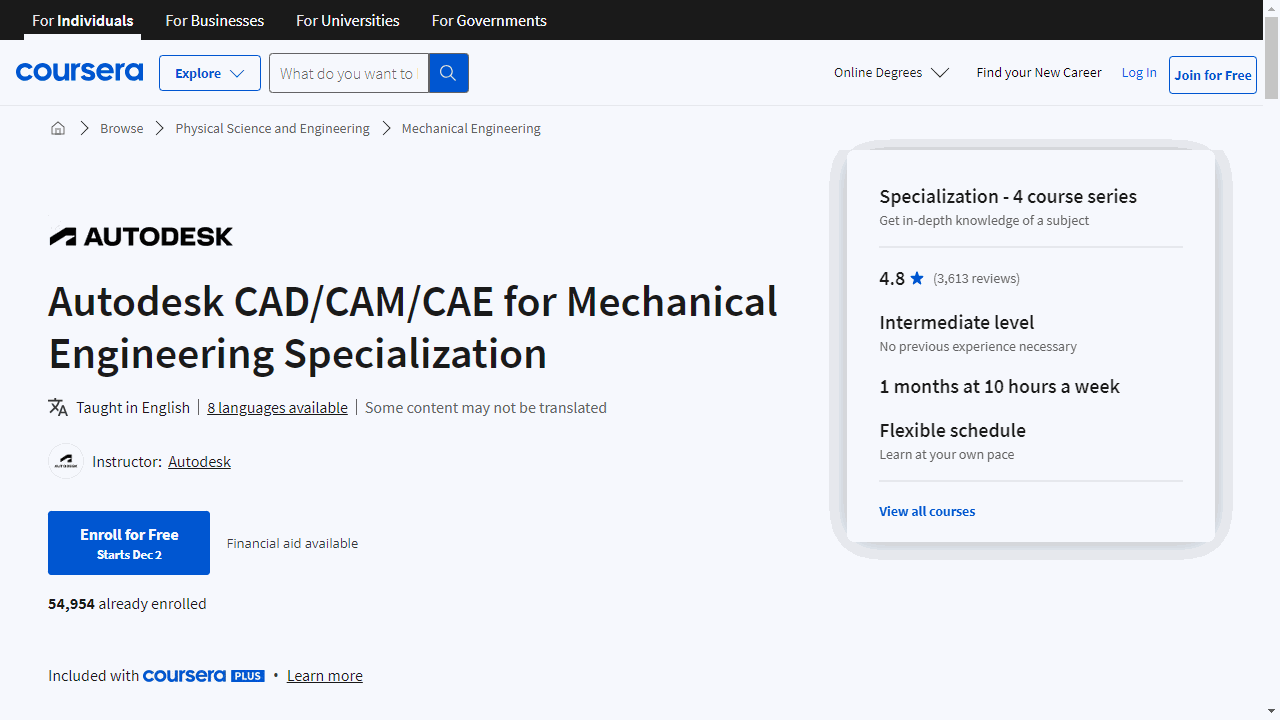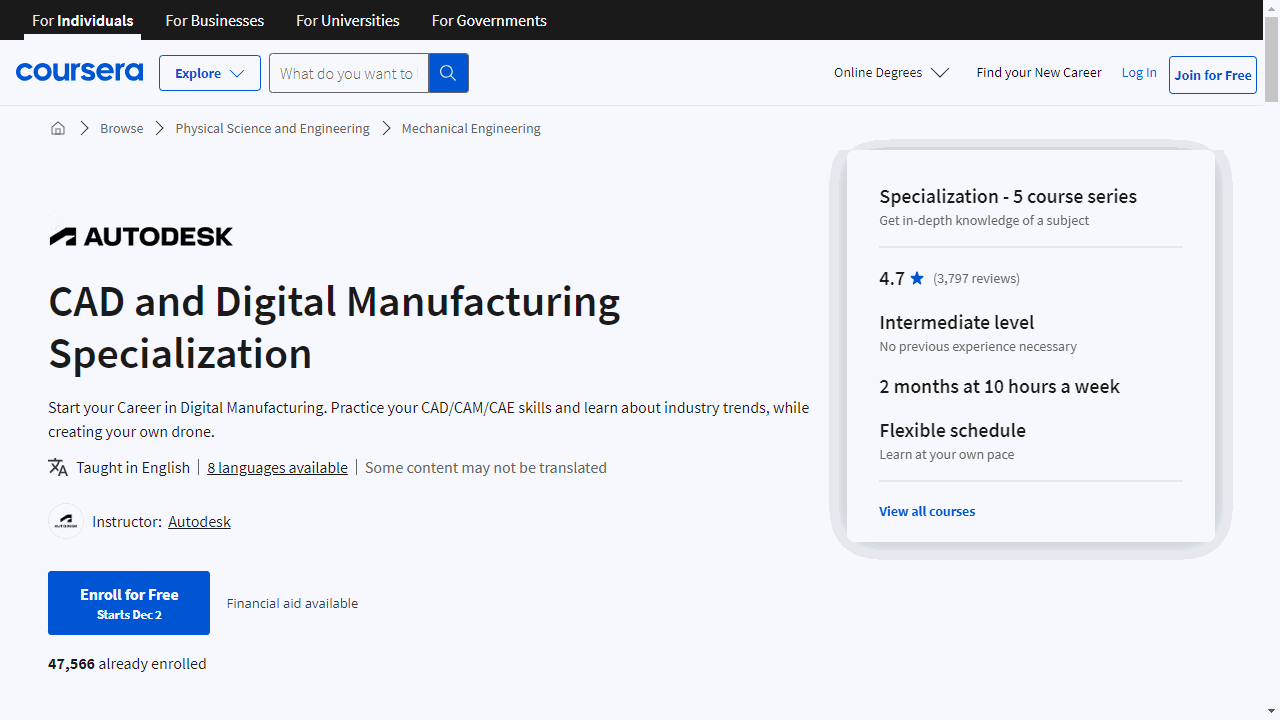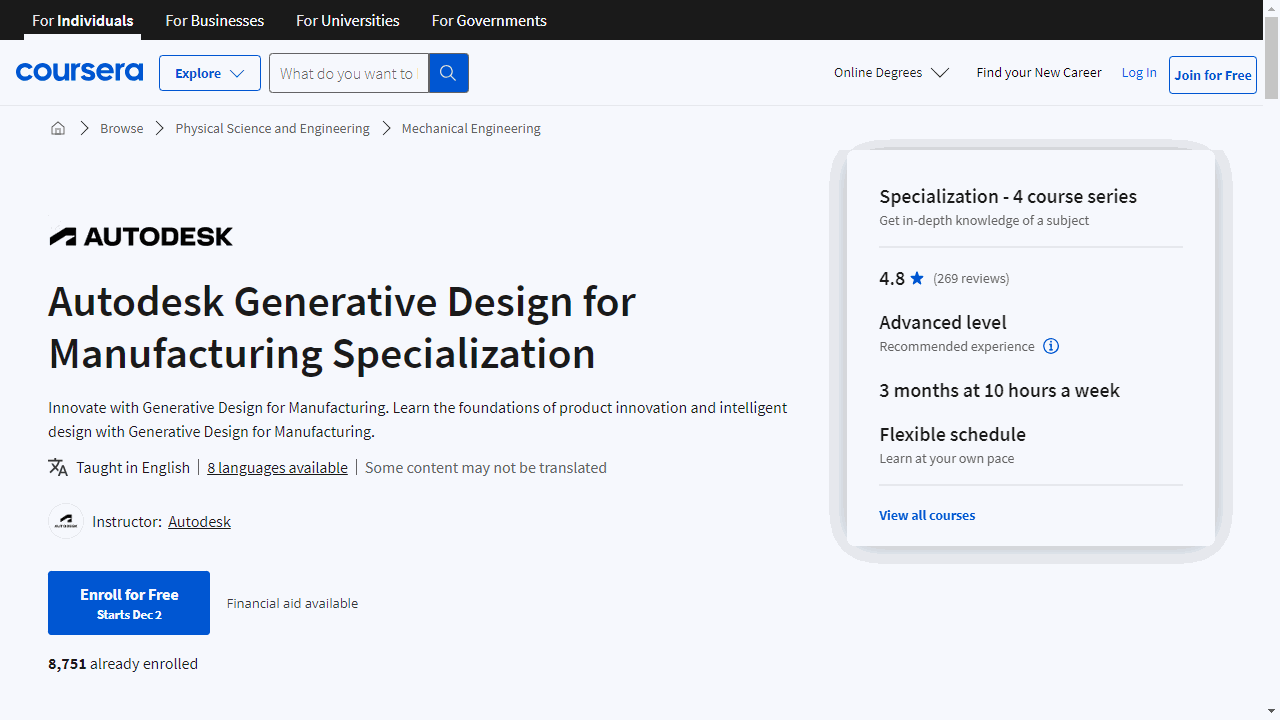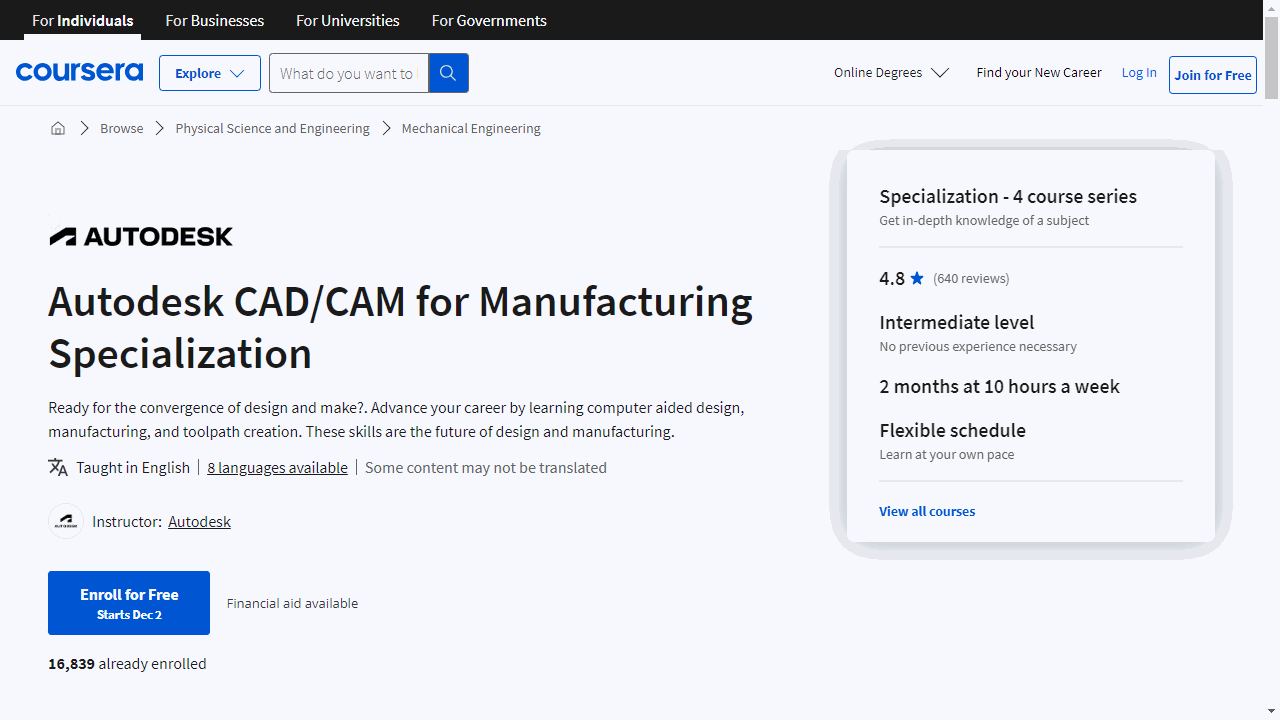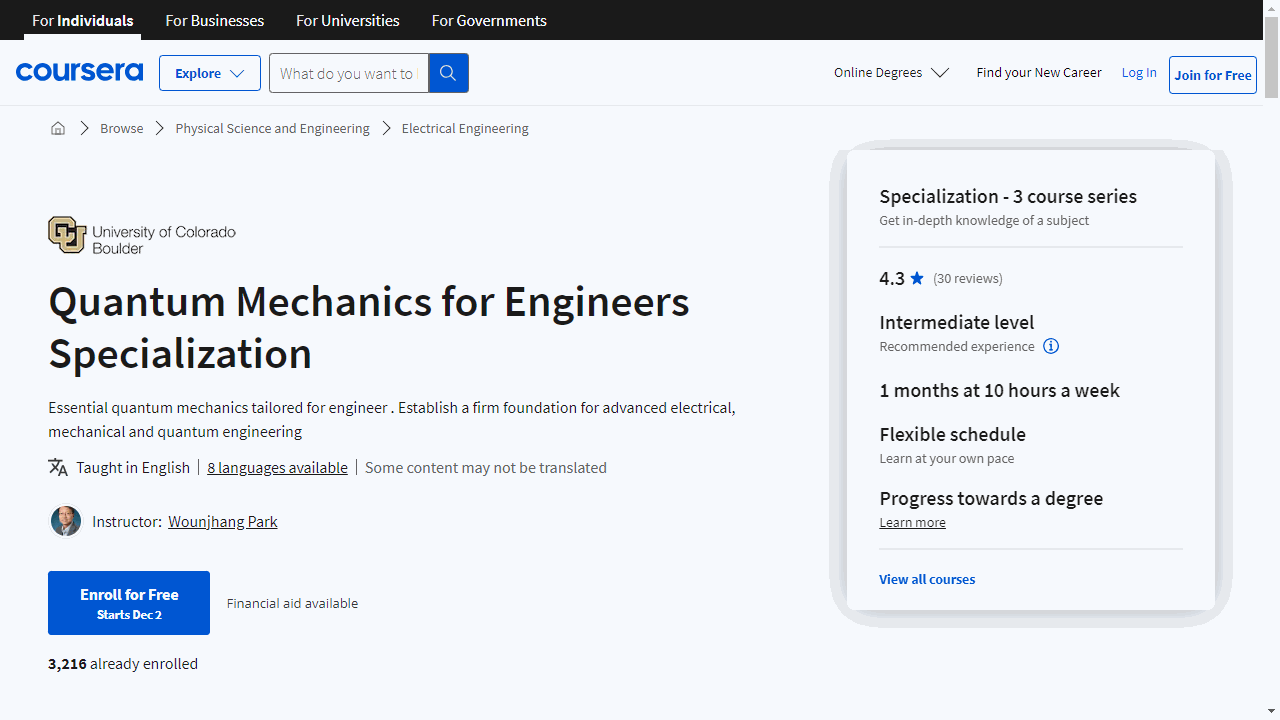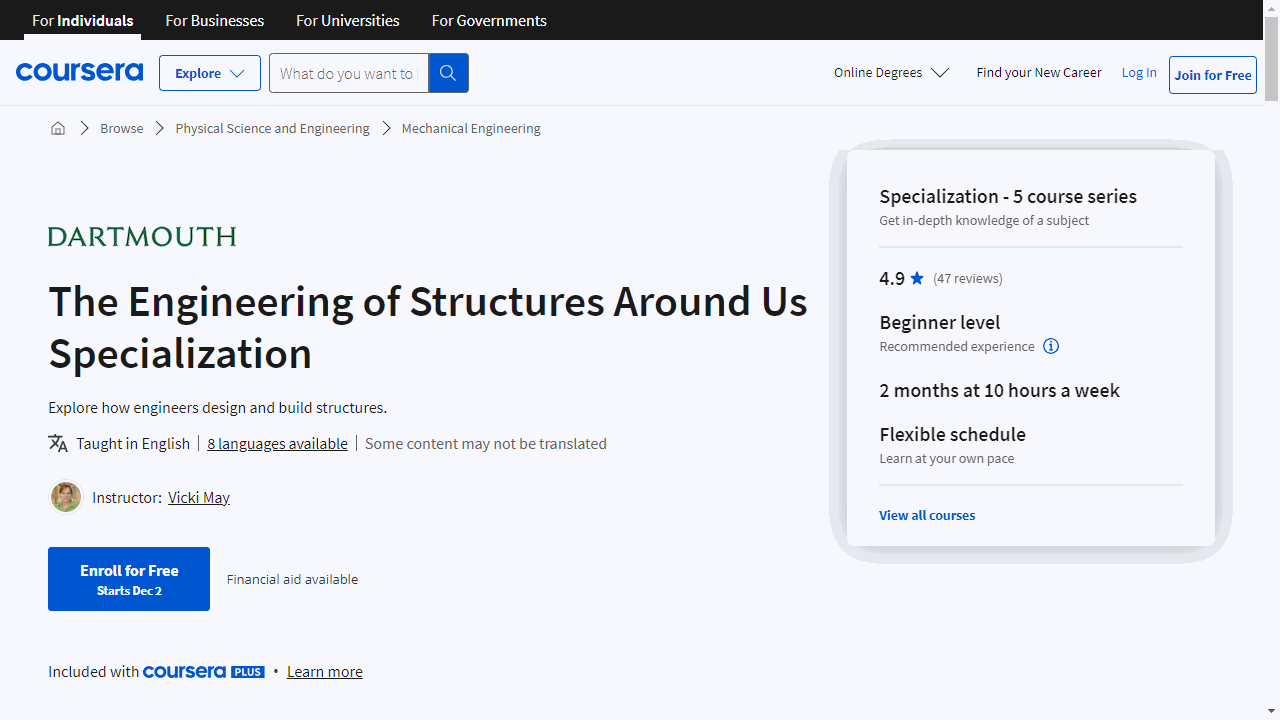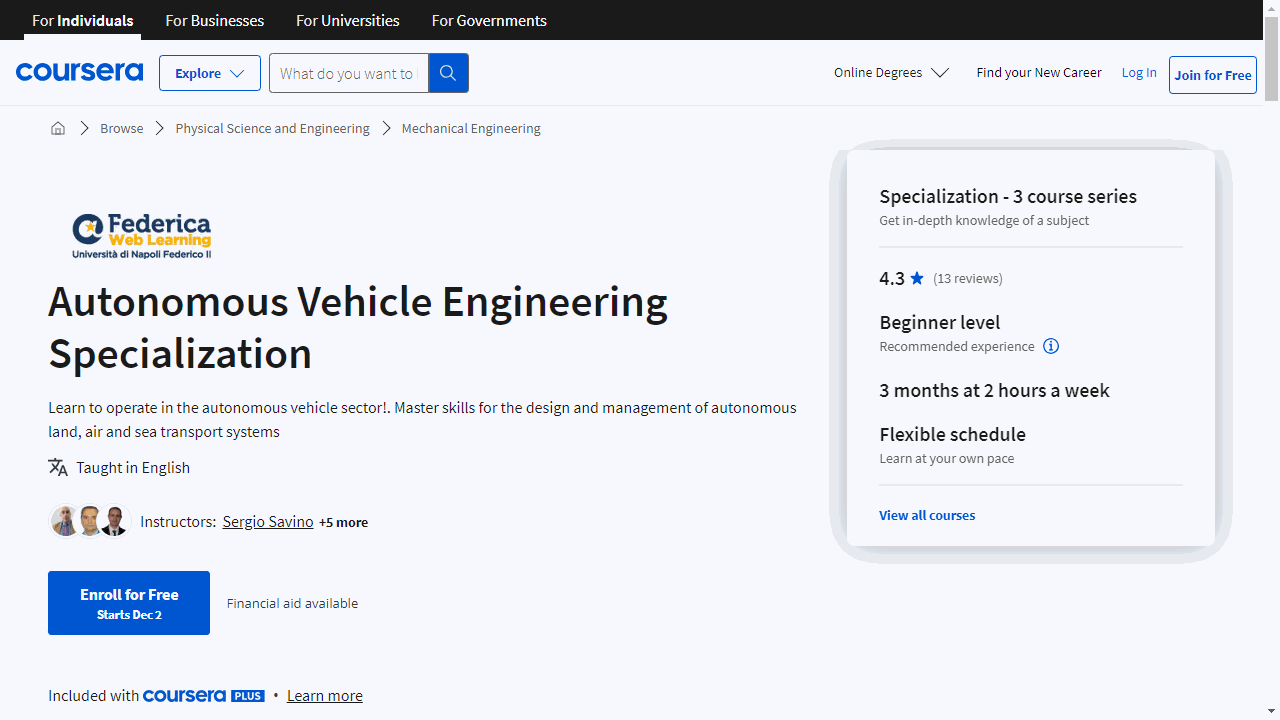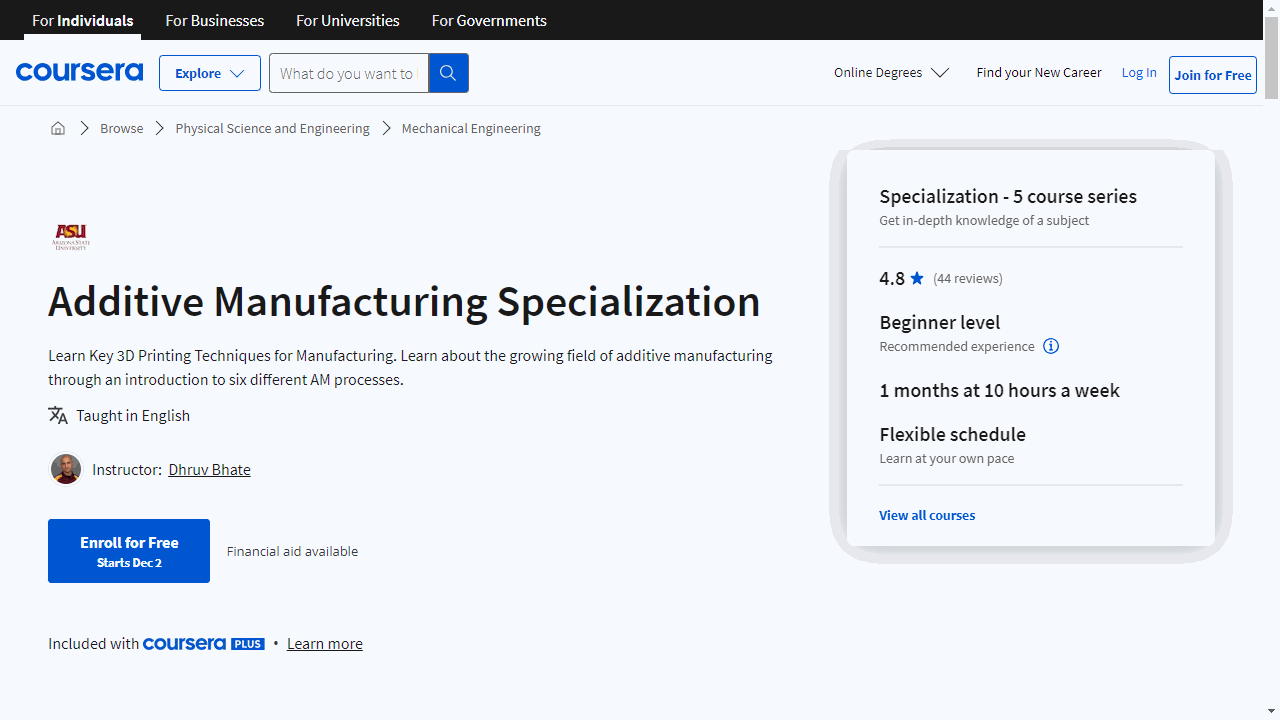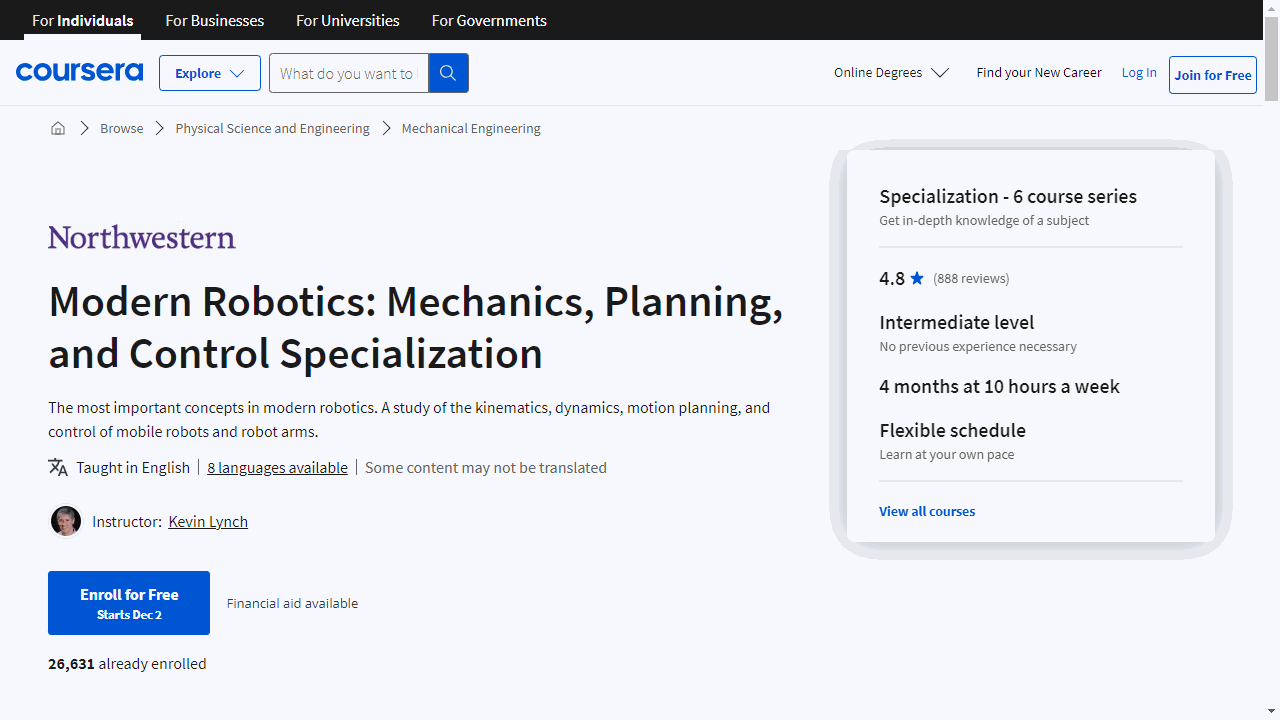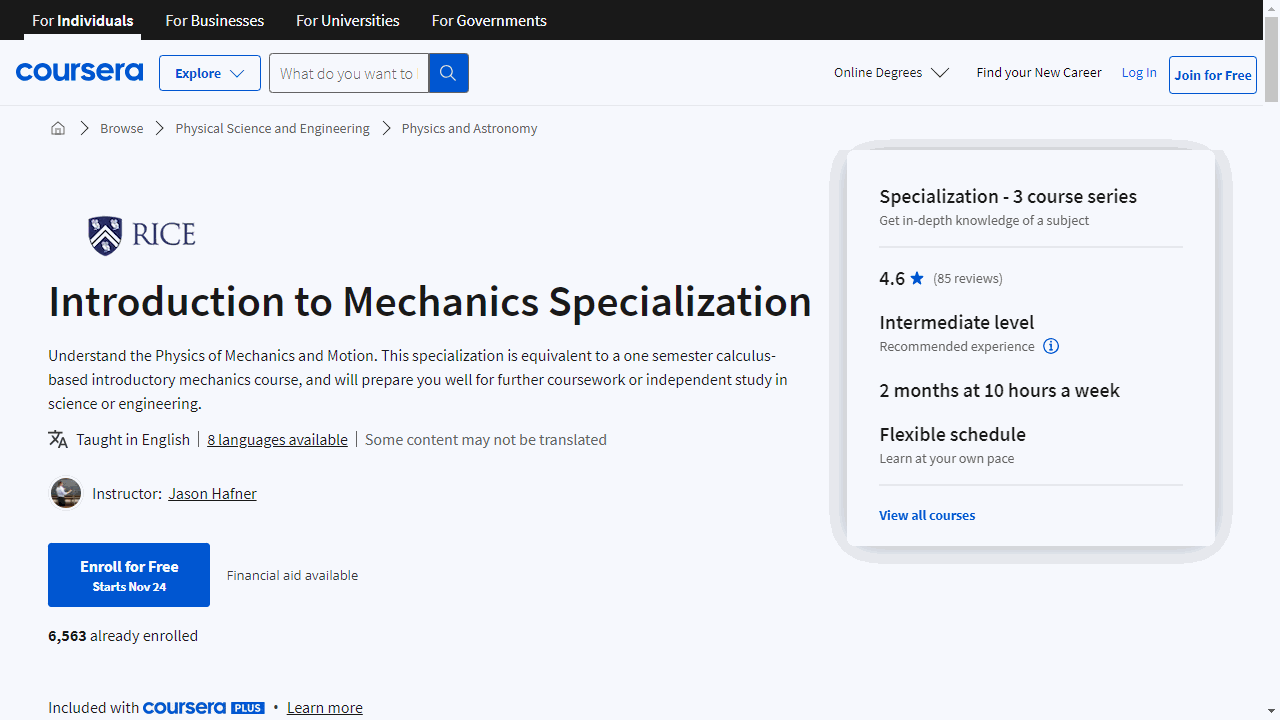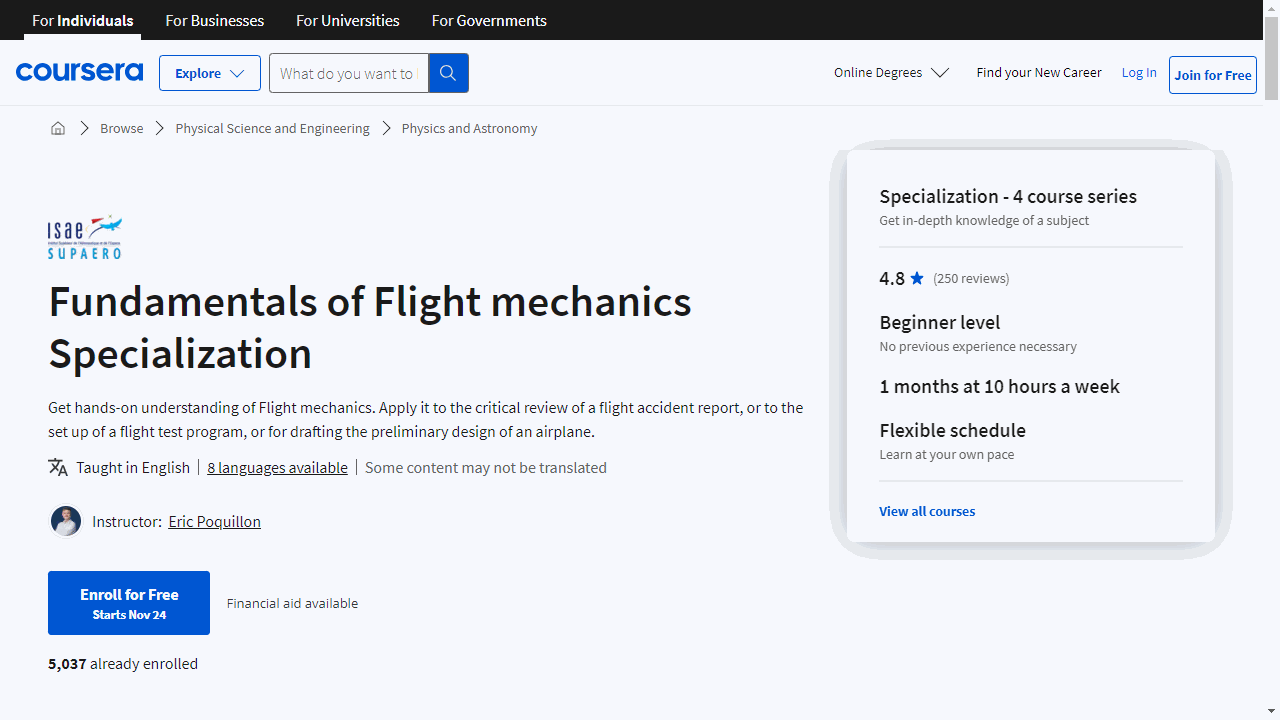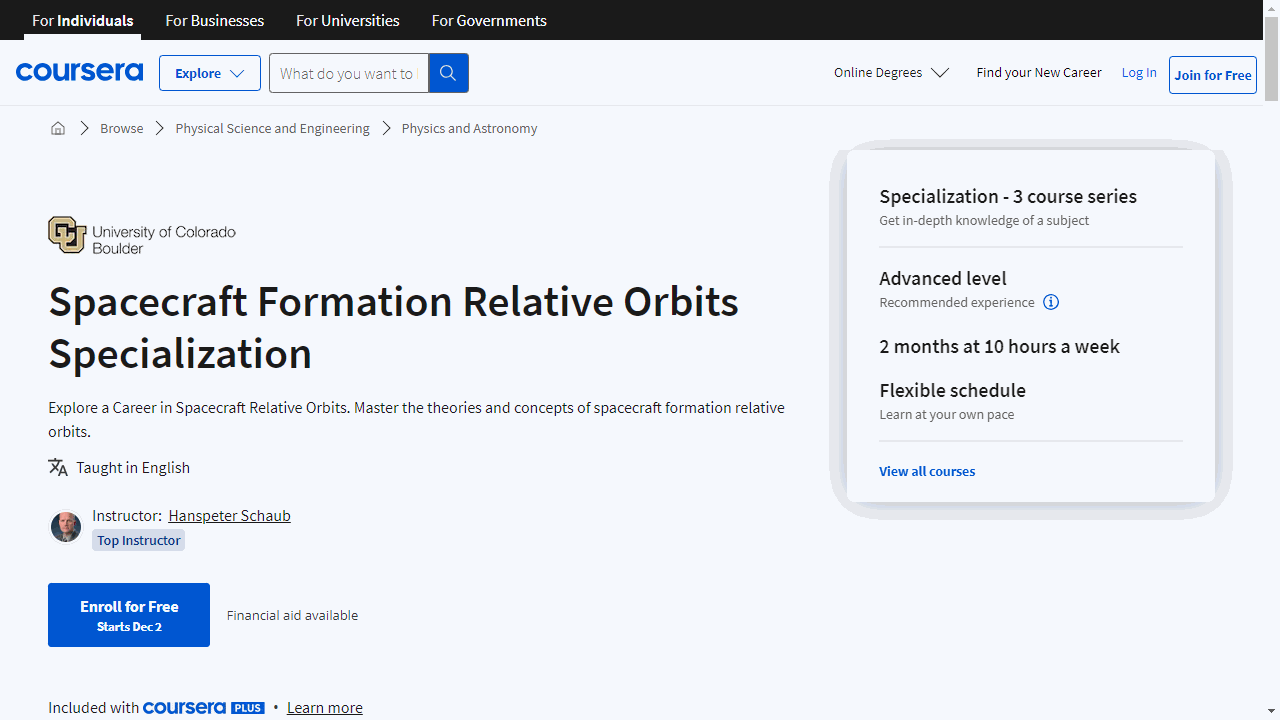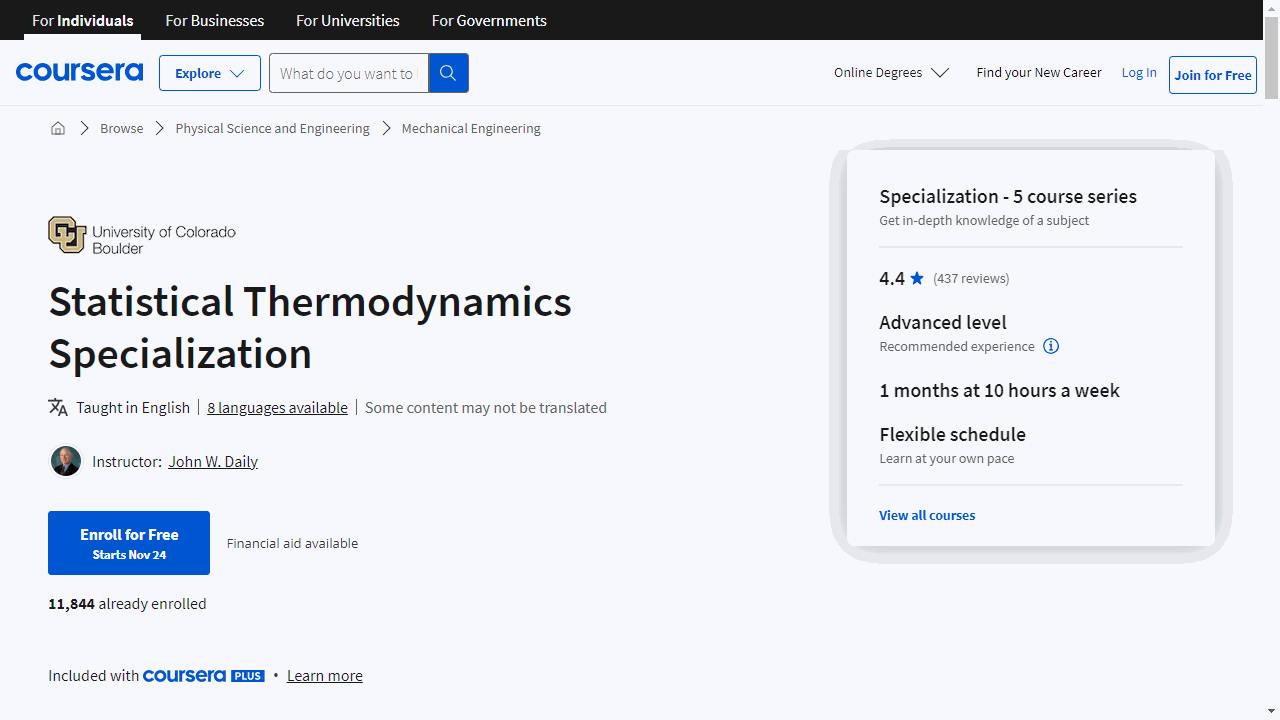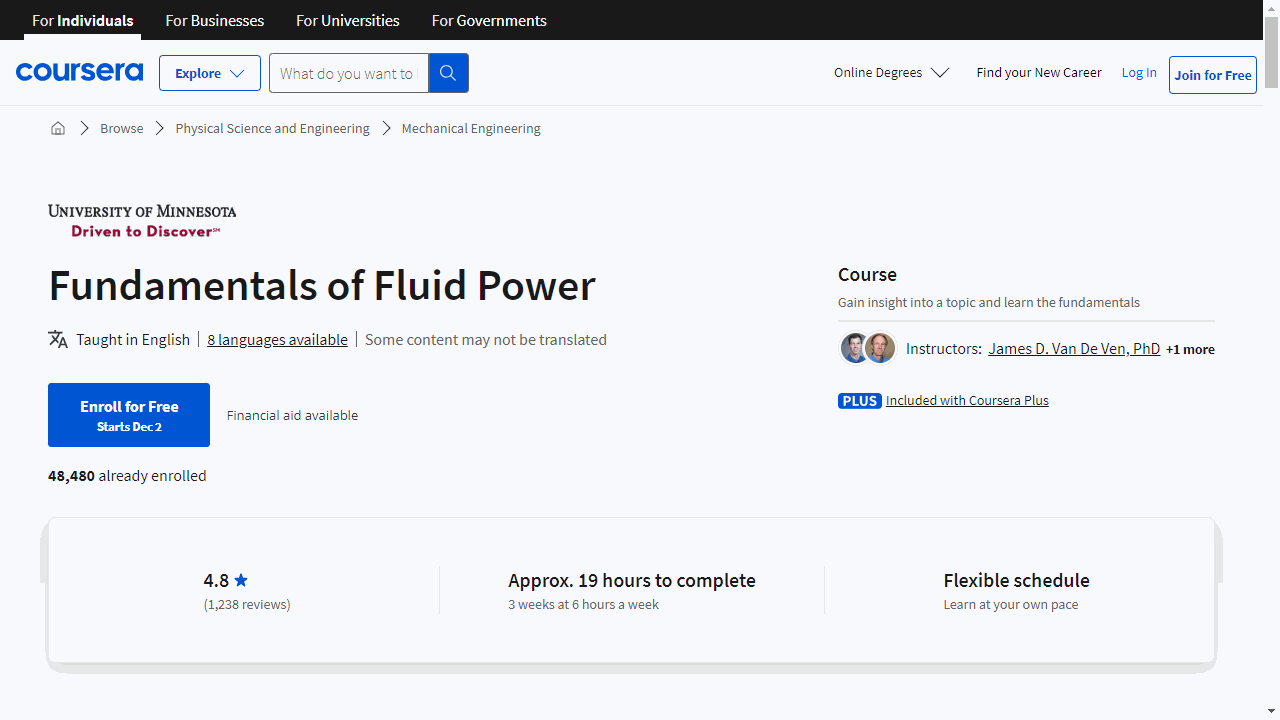Mechanical engineering is a dynamic field that involves the design, analysis, and manufacturing of physical systems.
From designing cars and airplanes to developing robots and medical devices, mechanical engineers play a crucial role in shaping the world around us.
By learning mechanical engineering, you can acquire valuable skills in areas like CAD software, mechanics, and materials science, opening doors to exciting career opportunities in various industries.
Finding the right mechanical engineering course on Coursera can be a challenge, given the vast number of options available.
You want a course that’s comprehensive, engaging, and taught by experts, but also fits your learning style and goals.
For the best mechanical engineering course overall on Coursera, we recommend the Autodesk CAD/CAM/CAE for Mechanical Engineering Specialization.
This specialization offers a comprehensive curriculum that covers essential skills in CAD software, design, simulation, and manufacturing, using Autodesk Fusion 360, a widely used tool in the industry.
While this is our top pick, there are other excellent courses available on Coursera that cater to different interests and skill levels.
Keep reading to discover more options, from foundational courses in mechanics to specialized programs in robotics, additive manufacturing, and more.
Autodesk CAD/CAM/CAE for Mechanical Engineering Specialization
This specialization is designed to build your proficiency in Fusion 360, an essential tool for mechanical engineers.
In “Introduction to Mechanical Engineering Design and Manufacturing with Fusion 360,” you’ll grasp the essentials of CNC programming, transitioning from digital models to physical prototypes.
You’ll get familiar with Fusion 360’s toolset, covering part design, assembly, and even simulation techniques.
Moving on to “Modeling and Design for Mechanical Engineers with Autodesk Fusion 360,” you’ll tackle the creation of gear assemblies and form-based designs.
This course equips you with the skills to design for functionality and manufacturability, ensuring your models are precise and production-ready.
“Simulation Analysis for Mechanical Engineers with Autodesk Fusion 360” is where you’ll learn to validate and refine your designs through simulation.
You’ll explore various simulation studies, from static stress to thermal analysis, to predict performance and enhance your designs before prototyping.
Lastly, “CAM and Design Manufacturing for Mechanical Engineers with Autodesk Fusion 360” teaches you to scrutinize assemblies and select appropriate manufacturing methods.
You’ll also learn to generate detailed drawings and toolpaths, essential for the manufacturing process.
CAD and Digital Manufacturing Specialization
This specialization also hones in on Autodesk Fusion 360, but also ensures you’re well-versed in the end-to-end process of digital manufacturing.
The first course, “Intro to Digital Manufacturing with Autodesk Fusion 360,” lays the foundation.
You’ll grasp the digital transformation in manufacturing, learn about sustainable and generative design, and get acquainted with Fusion 360’s collaborative environment.
Building on that, “Autodesk Fusion 360 Integrated CAD/CAM/CAE” merges design, engineering, and manufacturing into practical exercises.
You’ll tackle 3D modeling, rendering, and simulation, equipping you with sought-after skills in the job market.
In “3D Model Creation with Autodesk Fusion 360,” you’ll translate concepts into tangible 3D models.
This course emphasizes the design phase, from ideation to the final presentation of your model, using Fusion 360’s robust features.
“Engineering Design Process with Autodesk Fusion 360” delves into the iterative nature of design.
You’ll explore mechanical assemblies and run simulations to refine your designs, gaining advanced knowledge in Fusion 360’s engineering capabilities.
Lastly, “Manufacturing Process with Autodesk Fusion 360” bridges the gap between design and production.
You’ll understand CNC machining and the integrated CAD/CAM approach, culminating in assembling and testing a quadcopter.
Autodesk Generative Design for Manufacturing Specialization
This series helps you master generative design and the intricacies of 3D printing.
The course “Generative Design for Additive Manufacturing” will guide you through the essentials of creating 3D printable designs using Autodesk Fusion 360.
You’ll adopt a new design mindset, focusing on material placement for optimal part creation.
Keep in mind, access to Fusion 360 is required, so ensure you have a subscription before enrolling.
For enthusiasts of optimizing part performance, “Generative Design for Performance and Weight Reduction” offers insights into reducing weight while enhancing strength, particularly in the context of motorcycle parts.
This course demonstrates how generative design can simultaneously address these typically conflicting goals.
In “Generative Design for Industrial Applications,” you’ll explore the iterative nature of engineering design.
Learn to refine traditional manufacturing methods with generative design, assessing the benefits and trade-offs of each approach.
Lastly, “Generative Design for Part Consolidation” focuses on streamlining the manufacturing process by reducing the number of parts in an assembly.
This approach not only simplifies production but also can lead to stronger, more efficient designs.
Throughout these courses, you’ll develop skills in CAD, Autodesk Fusion 360, and generative design, preparing you for the evolving landscape of mechanical engineering.
Before you start, ensure you have a Fusion 360 subscription to complete the coursework.
Autodesk CAD/CAM for Manufacturing Specialization
This series is tailored to equip you with expertise in CAD, CAM, and CNC machining using Autodesk Fusion 360.
Start with “Introduction to CAD, CAM, and Practical CNC Machining,” where you’ll grasp the essentials of 3D modeling and CNC basics.
It’s a foundational course that sets the stage for all your designs and manufacturing work.
Next, “3-Axis Machining with Autodesk Fusion 360” takes you deeper into crafting complex geometries.
You’ll master the art of removing material from intricate parts using advanced toolpaths, preparing you for more sophisticated manufacturing tasks.
If you’re interested in lathe operations, “Creating Toolpaths for a CNC Lathe” focuses on the unique aspects of lathe toolpaths, tools, and coordinate systems.
It’s crucial for precision in turning operations.
For a challenge, “Multi-Axis CNC Toolpaths” introduces you to the world of 4th and 5th axis machining.
This course is your gateway to understanding and applying multi-axis toolpaths for creating highly complex parts.
Completing the specialization earns you an Autodesk Credential, a digital badge that showcases your skills and keeps you current with industry trends like generative design.
This credential can be a valuable asset on your resume and LinkedIn profile.
To further your learning, additional resources for Autodesk Fusion 360 certification are available on the Autodesk learning site.
Quantum Mechanics for Engineers Specialization
This series of courses from CU Boulder will equip you with a deep understanding of quantum mechanics principles and their applications in engineering.
Start with “Foundations of Quantum Mechanics” to build your base.
You’ll tackle core concepts like wave-particle duality and the evolution of quantum states, while sharpening your math skills in differential equations and linear algebra.
This course ensures you grasp the quantum mechanical framework necessary for advanced studies.
Move on to “Theory of Angular Momentum” to delve into the quantum nature of rotational motion.
Master the use of angular momentum operators, and learn to solve eigenvalue equations.
This knowledge is crucial for analyzing electron behavior in atoms, a skill that’s invaluable in fields like materials science and nanotechnology.
Finally, “Approximation Methods” teaches you to navigate complex quantum problems with practical approximation techniques.
From perturbation theory to the variational method, you’ll learn to find approximate solutions, a skill that’s essential when exact answers are elusive.
The Engineering of Structures Around Us Specialization
If you’re eager to strengthen your understanding of structural engineering, this specialization is tailored for you.
This series is a deep dive into the forces that shape the structures we rely on every day.
Start with “Engineering of Structures: Tension” to grasp how tension, the force of pulling, is essential in structures.
You’ll explore how cables and ropes manage this force and compare different bridge designs, like suspension and cable-stayed bridges, to understand their reliance on tension.
Move on to “Engineering of Structures: Compression,” where you’ll learn about the force of pushing and how it’s countered by architectural elements like arches and domes.
This course will guide you through the creation of anti-funicular forms, showcasing how structures withstand compression.
In “Engineering of Structures: Tension and Compression,” you’ll see how these two forces interplay in innovative structures.
You’ll delve into tensegrity structures and trusses, learning to calculate the forces within a truss and gaining insights into structural determinacy.
“Engineering of Structures: Shear and Bending” introduces you to shear forces—like those from cutting—and bending, as seen in curved elements under load.
You’ll understand how beams respond to these forces and get hands-on experience by constructing a cardboard beam.
Lastly, “Engineering of Structures: Response of Structures” covers how large buildings react to various forces, including those from natural disasters like earthquakes.
You’ll explore different types of loads, model large structures, and understand the significance of Single Degree of Freedom (SDOF) systems.
By engaging with these courses, you’ll not only master key engineering concepts but also apply them practically by building models and using design software.
Autonomous Vehicle Engineering Specialization
If you’re eager to master autonomous systems for vehicles, this specialization is a solid choice.
Dive into “A quick tour on Big Data and Business Intelligence” to get a solid foundation in AI and big data concepts.
You’ll learn to manage and extract value from large datasets, and even design AI processes.
Skills like using Apache Hadoop could set you on the path to becoming a Data Scientist or Big Data Architect.
In “Autonomous Aerospace Systems,” you’ll focus on creating sophisticated driving and navigation solutions for autonomous vehicles.
You’ll explore the integration of sensor data for vehicle positioning and movement, honing skills in modeling and simulation that are vital for developing virtual models in mechanical engineering.
“Modelling and simulation of mechanical systems” offers a deep dive into mechatronic systems, where mechanical engineering meets sensors and actuators.
Through case studies in robotics and smart devices, you’ll learn to create mathematical models and develop simulations using Matlab/Simulink.
Each course is designed to equip you with specific, applicable skills in the realm of mechanical engineering, with a special focus on autonomous technologies.
Additive Manufacturing Specialization
This is a comprehensive program that equips you with the know-how to navigate the expanding field of 3D printing.
Start with “Introduction to Additive Manufacturing Processes,” where you’ll grasp the basics of various 3D printing methods.
This course lays the foundation, guiding you from design concepts to the production of tangible parts.
It’s a practical first step, enriched by insights from graduate students who’ve recently mastered the material.
In “Material Extrusion,” you’ll delve into a common 3D printing technique, exploring the intricacies of fused deposition modeling.
This course also introduces you to composite extrusion, where materials like carbon fiber are combined with thermoplastics for enhanced strength.
“Material Jetting and Stereolithography” shifts focus to precision printing with photopolymer resins.
You’ll learn the specifics of preparing, executing, and finishing prints, understanding the applications best suited for these processes.
For a deeper dive into high-strength part production, “Selective Laser Sintering and Metal Laser Powder Bed Fusion” covers the use of lasers to fuse powder materials.
This course emphasizes the practical aspects of machine setup and post-processing for both polymers and metals.
Lastly, “Design for Additive Manufacturing” teaches you to assess whether 3D printing is the right choice for a part and how to optimize design for the printing process.
The DFAM staircase framework and a unique scorecard are tools you’ll use to make informed decisions.
Each course includes lectures, quizzes, and projects, ensuring a hands-on learning experience.
While supplemental materials are available, they’re optional, allowing you to tailor your learning to your needs.
Modern Robotics: Mechanics, Planning, and Control Specialization
This specialization is a practical and thorough pathway to mastering the mechanics, planning, and control aspects of robotics.
In “Course 1: Foundations of Robot Motion,” you’ll start by understanding robot configurations and the concept of configuration space (C-space).
You’ll learn about degrees of freedom, holonomic and nonholonomic constraints, and how to express spatial velocities and forces.
Moving on to “Course 2: Robot Kinematics,” you’ll apply your knowledge to solve forward kinematics problems, delve into velocity kinematics, and tackle inverse kinematics.
This course demystifies how a robot’s position and orientation are determined and controlled.
“Course 3: Robot Dynamics” introduces you to forward and inverse dynamics, equipping you with the skills to simulate and control robot movements.
You’ll also learn to plan trajectories that adhere to dynamic constraints.
In “Course 4: Robot Motion Planning and Control,” you’ll navigate the complexities of planning a robot’s path around obstacles and executing real-time motion control.
This course covers essential planning techniques and control strategies.
“Course 5: Robot Manipulation and Wheeled Mobile Robots” explores advanced topics, including robot grasping, manipulation, and the dynamics of wheeled robots.
You’ll gain insights into controlling complex robot systems that combine mobility and manipulation.
The program culminates with “Course 6: Capstone Project, Mobile Manipulation,” where you’ll integrate your skills to control a mobile manipulator.
You’ll program a robot to perform tasks in a simulated environment, using the KUKA youBot as your model.
Throughout the specialization, you’ll develop a robotics software library in Python, Mathematica, or MATLAB and use the free V-REP robot simulator for hands-on practice.
The courses are aligned with the textbook “Modern Robotics: Mechanics, Planning, and Control,” available for purchase or as a free preprint PDF.
Introduction to Mechanics Specialization
This series is crafted to build your understanding of physics from the ground up, with a focus on practical problem-solving skills that mirror real-world scenarios.
The journey begins with “Physics 101 - Forces and Kinematics,” where you’ll grasp the fundamentals of motion.
Through engaging video lectures and interactive quizzes, you’ll master 1D and 2D Kinematics and Newton’s Laws, employing tools like algebra and calculus.
The course is designed to be hands-on, with free textbook resources and homework problems that ensure you’re not just passively learning but actively applying your knowledge.
Progressing to “Physics 101 - Energy and Momentum,” you’ll delve into the concepts of mechanical energy and momentum.
This course demystifies the principles governing energy transfer and object interactions, with a special emphasis on real-life applications like collisions and material elasticity.
The structured modules guide you through each concept, culminating in an exam that benchmarks your proficiency.
The final course, “Physics 101 - Rotational Motion and Gravitation,” rounds out your foundational physics education.
Here, you’ll explore the intricacies of angular momentum and the universal law of gravitation.
The course content, which includes rotational motion and the forces that govern planetary orbits, is delivered through comprehensive lectures and problem sets that challenge and expand your understanding.
Each course in the specialization mirrors the rigor of Rice University’s on-campus offerings, ensuring you receive a high-quality education.
Upon completion, you’ll not only be equipped to tackle advanced physics courses but also possess a robust framework for analyzing motion and energy in any context.
Fundamentals of Flight Mechanics Specialization
If you’re intrigued by the physics of flight, the “Fundamentals of Flight Mechanics Specialization” on Coursera offers a clear and engaging path to understanding how aircraft operate.
This series of courses is designed to demystify the principles of flight, making complex concepts accessible to all learners, regardless of their math skills.
In “Flight Mechanics - The Basis,” you’ll start by learning the vocabulary of aviation and the fundamental principles that govern an aircraft’s movement.
The course emphasizes practical understanding, using visual aids to complement the technical aspects, ensuring you can grasp the material even if you skip the math.
Moving on to “Flight Mechanics - Anemobarometry,” you’ll delve into atmospheric physics and its impact on flight.
This course clarifies how pilots interpret speed and altitude readings, and why understanding the atmosphere is crucial for safe flying.
It’s not just about numbers; it’s about real-world application and safety.
The third course, “Flight Mechanics - Lift and Trajectory,” focuses on the concept of lift.
You’ll explore how speed and angle of attack influence an aircraft’s ability to stay airborne and learn about flight limitations such as stalls and flutter.
This knowledge is vital for anyone interested in the operational aspects of flying.
Lastly, “Flight Mechanics - Propulsive Balance and Energy” covers the essentials of energy management in aviation.
You’ll examine the interplay between drag and thrust and how they affect an aircraft’s speed and altitude.
This course provides insights into the mechanics of efficient flight and the factors that pilots must manage to ensure a smooth journey.
Each course in this specialization is rich with technical details yet presented in a way that’s digestible for learners at all levels.
Whether you’re a student, a professional, or simply a physics enthusiast, these courses will deepen your understanding of the forces at play in the skies above.
Spacecraft Formation Relative Orbits Specialization
This trio of courses is a deep dive into the complexities of spacecraft motion and control, offering a blend of theoretical knowledge and practical application.
The journey begins with “Spacecraft Relative Motion Kinematics and Kinetics.”
Here, you’ll learn to describe the intricate motion between spacecraft using various coordinate systems.
You’ll tackle the challenge of developing differential equations that capture this relative motion, including the effects of Earth’s oblateness, known as the J2 perturbation.
This course equips you with the ability to predict and manage the paths of spacecraft in relation to each other.
Next, “Spacecraft Relative Motion Control” shifts your focus to the art of maintaining a stable path for spacecraft.
You’ll explore nonlinear control theory and apply it to real-life scenarios, ensuring that spacecraft can safely approach and maintain their positions.
This course is about precision and control, ensuring that spacecraft can navigate the complexities of space interaction without incident.
Finally, the “Spacecraft Formation Flying and Control Capstone Project” puts your skills to the test.
You’ll design strategies to approach and maneuver around tumbling space debris.
This capstone project simulates the challenges of real-world space missions, requiring you to apply your knowledge of relative motion and control to ensure a safe and successful operation.
These courses are advanced, designed for those with a solid foundation in math and physics.
You’ll gain a robust set of skills, including variational equations, stability analysis, and trajectory design, all of which are crucial for a career in spacecraft engineering and beyond.
Statistical Thermodynamics Specialization
Starting with “Fundamentals of Macroscopic and Microscopic Thermodynamics,” you’ll delve into the core principles like temperature and pressure.
This course demystifies the link between the microscopic world of molecules and the macroscopic properties we observe, setting a solid foundation for your journey.
Moving on to “Quantum Mechanics,” the specialization takes a leap into the quantum realm.
You’ll tackle the Schrödinger wave equation and gain insights into atomic behavior.
The course simplifies complex quantum chemistry, providing you with practical skills to solve quantum problems.
“Ideal Gases” shifts the focus to systems where intermolecular forces take a backseat.
You’ll explore various gas behaviors and their industrial relevance, learning to predict how gases will respond under different conditions using partition functions.
In “Dense Gases, Liquids and Solids,” the course examines what happens as gases condense.
You’ll understand the transition from gas to liquid and solid states, and learn to use the radial distribution function to analyze liquid properties.
Lastly, “Non-Equilibrium Applications of Statistical Thermodynamics” applies your knowledge to dynamic systems.
From gas transport properties to the intricacies of chemical kinetics, this course covers essential topics like spectroscopy and computational tools for kinetic calculations.
Fundamentals of Fluid Power
This course by the University of Minnesota zeroes in on fluid power, a cornerstone of mechanical systems, covering both hydraulics and pneumatics.
You’ll begin with the essentials, learning about cylinders and the key variables in fluid power.
The course emphasizes understanding two fundamental laws vital to fluid power systems and strategies to maximize efficiency.
As you progress, you’ll delve into the dynamics of fluid flow, tackling concepts like fluid viscosity and the factors causing pressure drops in pipes and fittings.
The Moody diagram will become a tool in your arsenal for designing efficient systems.
Valves and pumps take center stage in subsequent lessons, where you’ll explore their functions and the intricacies of pump selection, including their role in hydrostatic transmissions.
Practical safety measures, such as the use of pressure relief valves, are also highlighted.
Simulation software, Simscape Fluids, introduces a hands-on element, allowing you to model and test fluid power systems virtually.
This interactive approach reinforces theoretical knowledge with practical application.
In the latter weeks, you’ll examine fluid properties, such as compressibility and inertia, and their impact on system behavior.
The course also touches on advanced topics like servohydraulics and the principles behind hydraulic hybrid vehicles.
Throughout the course, homework assignments ensure you apply what you’ve learned, and forums provide a space for discussion and knowledge exchange.
